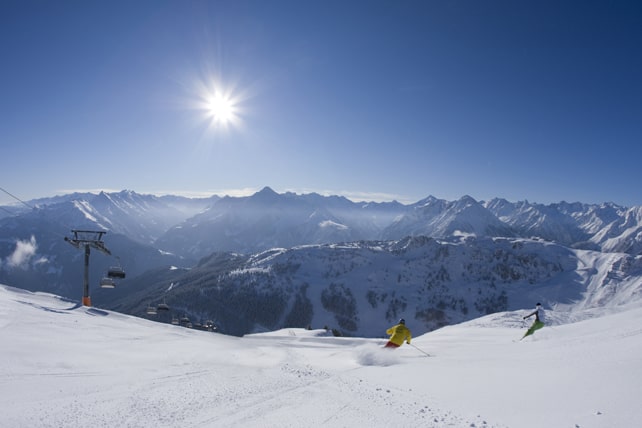
Andy Perrin started out as a resort rep in St Johann in Tirol in the 1980s in a bid to improve his German and learn how to ski. Today he is CEO of Hotelplan UK – the parent company of specialist ski companies Inghams, Esprit Ski and Ski Total.
It’s always amazed me how some ski areas get all the praise and publicity – and others are barely talked about. It’s a shame. Not only does it mean some resorts are unfairly overlooked, but it also draws skiers to a handful of destinations like bears to a honeypot – and their pistes can be uncomfortably crowded as a result. So here, by way of a corrective, are ten which I think deserve wider recognition.
You might be surprised to see some famous names amongst them: but that’s because I’m talking about the quality of the skiing they offer, not their reputation for nightlife, film festivals or glamour.
St Moritz in Switzerland is a good example of this phenomenon. Everyone’s heard of it, and knows its high-falutin’ reputation. What many fewer people realise is how good the skiing is on its slopes. Spend your holiday there and you could making big, bold turns on empty pistes while everyone else is jostling for a bit of elbow room elsewhere.
Breckenridge, USA
ARVE Error: For the maxwidth (maxw) option you need to have normal or lazyload mode enabled, either for all videos in the plugins options or through shortcode e.g. [youtube id=123456 mode=normal maxw=999 ].
For years, Breckenridge has been a popular resort – quick to get to from Denver airport, well-stocked with mid-priced accommodation, and buzzing with great bars. (The Gold Pan Saloon on Main Street is a classic, and dates back to 1879, but you’ll love Downstairs at Eric’s, too, which has 30 beers on tap.)
What baffles me, though, is why the skiing doesn’t draw the same plaudits as Vail and Aspen, especially in the wake of its recent expansion onto Peak 6, which has increased the total terrain on offer by nearly a quarter.
Yes, it’s long been known as the home of the soothing groomer: the kind of broad, easy-skiing piste which will boost the confidence of any intermediate. It’s also is a key resort for freestylers.
But what’s less talked about is the way Breck can develop the skills and self-belief of more advanced skiers. I’m not talking here about proper, self-sufficient experts, but the kind of skiers who are comfortable on black pistes in the Alps, but never seem to progress further.
Breck has masses to offer in this respect: wide-open, high-mountain bowls, tree runs, bumps, chutes – and it’s all protected against avalanches by blasting. So you can ski where you please, stretching your technique in ways no amount of Alpine-style piste-bashing can match.
Maybe you won’t notice the difference at first. But a sure sign of how this kind of skiing improves your skill is the moment you get back onto a groomed piste, suddenly realise “this is easy”, and really enjoy carving your turns.
Best Run: Beyond Bowl, accessed from Peak 6, is a wide-open, go-anywhere place when conditions are right – offering steep, sustained skiing which is perfect for anyone getting to grips with off-piste terrain.
Best Restaurant: (in town) Relish is the place. Set just off Main Street and up a flight of stairs it’s owned chef Matt Fackler and turns out well-balanced, imaginative food in an unpretentious atmosphere. No wonder it’s a locals’ favourite.
Bad Kleinkirchheim, Austria
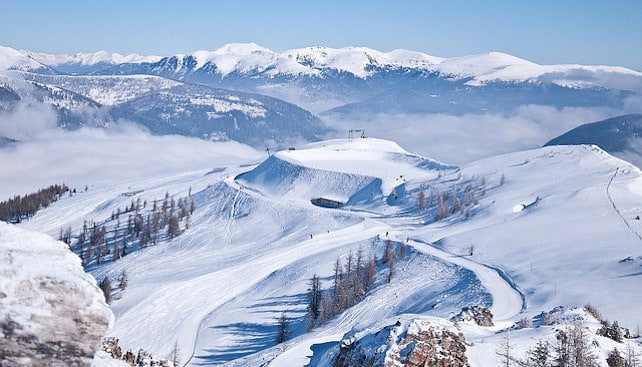
Bad Kleinkirchheim – or BKK as it’s usually known – is the home resort of Austrian super-hero Franz Klammer, one of the greatest downhill skiers of all time.
The old spa town in the province of Carinthia is linked across the mountain to neighbouring St Oswald and provides 103km of easy, attractive skiing on undulating summer pastureland.
The gentle terrain of the Nockberge Mountains makes the ski area perfect for beginners, intermediates and families rather than mileage-hungry pleasure seekers. However, The World Cup downhill course, designed by Klammer himself, includes a sequence of jumps that, even when prepared as a recreational run, require some concentration.
The top lift goes up to just over 2000m, so you’ll need to avoid the start and end of the season if you can.
Apart from the skiing, BKK is a serious spa destination, perfect for those who like nothing more than to wallow in the mineral-rich healing waters of a traditional spa – and for those who are here for cures of all sorts.
Best Run: the Franz Klammer World Cup run, 3200m long.
Best Restaurant: the Klammerstubn for regional treats.
La Rosiere, France
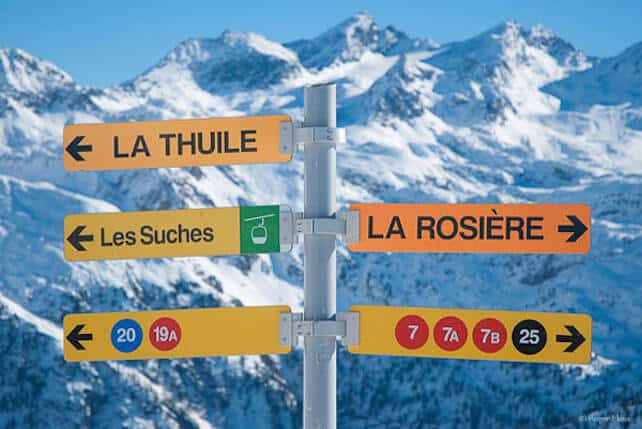
La Rosiere may have a reputation as a great destination for families. But that doesn’t mean it doesn’t come with some great skiing attached. Set beneath the Petit St Bernard pass, on the border with Italy, it shares its lift system with La Thuile, on the other side of the frontier, and serves up a mix of long, confidence-boosting intermediate-level pistes and some unexpected treats for more advanced skiers.
Not only is it home to the Fontaine Froide (covered in the Welove2ski feature on the 10 best ski runs in France), it also serves as a base for heli-skiing on the Ruitor Glacier in Italy. You’ll also find some cracking black-rated pistes in La Thuile. So while the little ones are making pizza shapes on the nursery slopes, Mum and Dad can ski like maniacs until their legs explode.
Best Run: the long red Fontaine Froide run from above La Rosiere down to Ecudets.
Best Restaurant: L’Antigel was new in 2013 and is in a wood and stone chalet with an open fireplace.
Monterosa, Italy
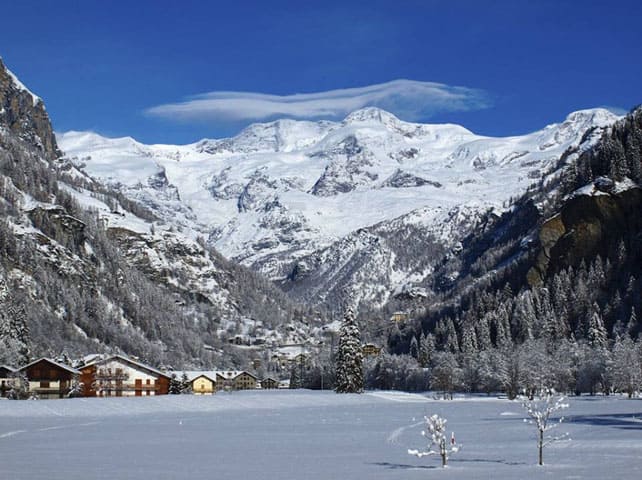
The Monterosa ski area in the Aosta Valley is well known to serious off-pisters. Clinging to the side of mighty Monterosa massif, it spreads across three deep and magnificent valleys, and offers lift access to a mind-boggling array of expert-only descents.
It’s also the home of relatively inexpensive heli-skiing operation. If you’ve ever been tempted by the idea of a heli-skiing trip in Canada, but are put off by the cost, come and try it here first.
Ask any other kind of skier to place it on a map, however, and he or she will probably struggle. And that’s a good thing, because Monterosa’s low profile has kept it under-developed, and preserved the kind of villagey atmosphere you seldom find in A-list resorts.
Champoluc and Gressoney are the two best bases for piste skiers: cute, uncrowded and peppered with some great mountain restaurants. They’re also home to some unusually long upper-intermediate pistes, which will drop you through a muscle-melting 1000 vertical metres, or more.
Best Run: the combination of black and red pistes down to Alagna feels like a real adventure.
Best Restaurant: Capanna Carla in Gressoney is a treat. Traditional Aosta Valley dishes in a creaking old chalet, full of atmosphere.
Park City, USA

The only reason most Brits have heard of Park City is because it hosts the Sundance Film Festival. But that’s about to change, because from the 2015-16 season, it’ll be linked by a new gondola to the Canyons next door, creating America’s biggest ski area.
In fact, at 7,300 acres, it’ll be 1,500 acres larger than its nearest rival (Big Sky in Montana), and will encompass every conceivable type of terrain – from one of the best top-to-bottom beginner trails in the business, to super-steep high-mountain bowls, bump runs and an Olympic Superpipe. All in all, nearly 300 waymarked runs will be on offer.
Three other factors deepen the appeal. First is Main Street, at the bottom of the lifts – which is offers one of the most enticing stretches of shopping, bars and restaurants in North American skiing. Second of all is the Utah snow – famously light and dry, and heaven to ski on a powder day.
And thirdly, Park City is a great launchpad for a ski safari through the rest of the Wasatch mountains. In particular, Snowbird and Alta, two valleys away in Little Cottonwood Canyon, are an essential day trip for advanced skiers and boarders who like their snow steep and deep.
Best Run: there’s a whole series of wide and sumptuous blue-rated trails underneath the King Con chair on the Park City side, which intermediates will love. Don’t pick one. Ski them all.
Best Restaurant: the fresh, oven-baked pizzas on the Canyons side at Cloud Dine are just the ticket after a hard morning’s skiing.
St Moritz, Switzerland
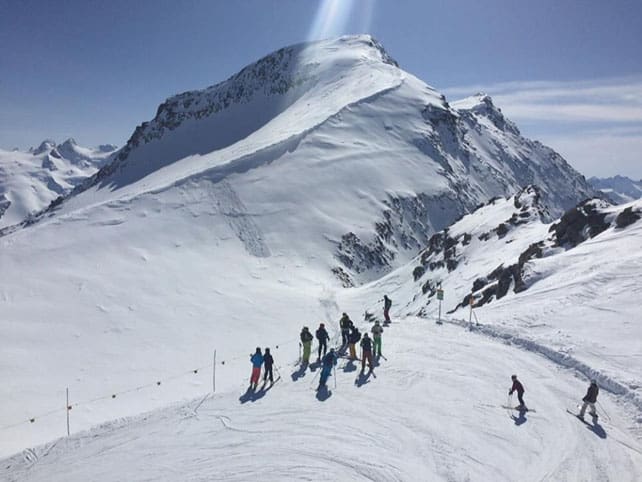
Yes, there’s a branch of Gucci on the via Serlas. Yes, they play snow polo on a frozen lake. St Moritz’s high-falutin’ image can be so blinding most people don’t realise that it’s also an amazing place to ski: and you only have to glance at the geography to understand why.
The Engadin Valley, in which it’s set, is high, remote and locked away beneath soaring peaks, in one of the coldest parts of the Alps. As a result, the snow is reliable, the scenery stunning and the upper-intermediate pistes world class. What’s more, because so many visitors are doing something else other than skiing (watching the polo, perhaps, or eating truffled pizzas in La Marmite), the slopes are – by Alpine standards – more or less deserted. Skiing them is a joyous experience.
St Moritz is also a ideal for those who want a wider experience of winter than simply whizzing downhill on skis. Take cross-country skiing for example. Not only is the Engadin valley home to one of the biggest cross-country marathons in the Alps (attracting 12,000 competitors a year), it’s also home to huge 220km network of trails, as well as several cross-country schools.
Or how about tobogganing? Most ski resorts are home to a handful of short, fun runs: but here there’s a whole mountain more or less set aside for it – the 2456m Muottas Muragl. Fact is, if it can be done on snow or ice, then it can be done in St Moritz.
Best Run: the deceptively-named “Standard” run from the top of Corvatsch mountain. It’s a red-rated intermediate piste, steady, sustained and set on top-quality snow. They should rename it. “Gold Standard” would do nicely.
Best Restaurant: actually, those truffled pizzas are delicious. It has to be of La Marmite.
Serre Chevalier, France
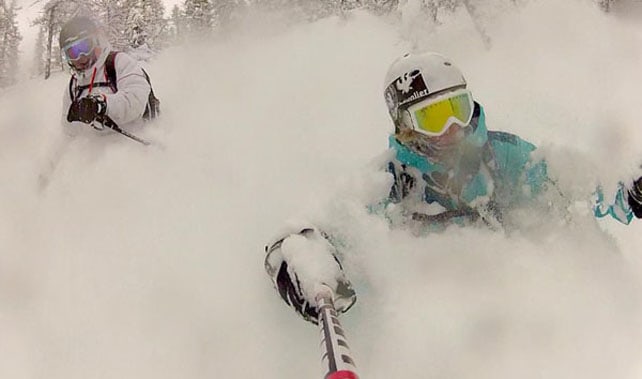
Looking for a big French ski area, with lots of variety – and relatively low prices? Then Serre Chevalier is the place. It claims a total of 250km of pistes, and offers good skiing both on-piste and off, both above and below the tree line. It’s never hit the big time like its rivals to the north, and is home to lots of inexpensive apartments and mid-priced hotels.
Apres-ski addicts will, admittedly, find its nightlife a little underpowered – which is down to the fact that there’s not one single bed base at the bottom of the lifts, but a series of villages, just off the road to Grenoble. But others love the laid-back and welcoming atmosphere.
One indication of the way Serre Chevalier tries harder are its Cols Porteurs tours: free, 90-minute tours of the ski area, every day of the week, for those who are comfortable skiing red-rated pistes. That kind of thing may be normal in North America, but it’s a rarity in the Alps.
Best Run: the Cucumelle – a long and cruisey red between the Monetier and Villeneuve areas.
Best Restaurant: above Villeneuve, Le Pi Maï which has lots of charm, good food, and you sit by a log fire.
Val di Fassa, Italy
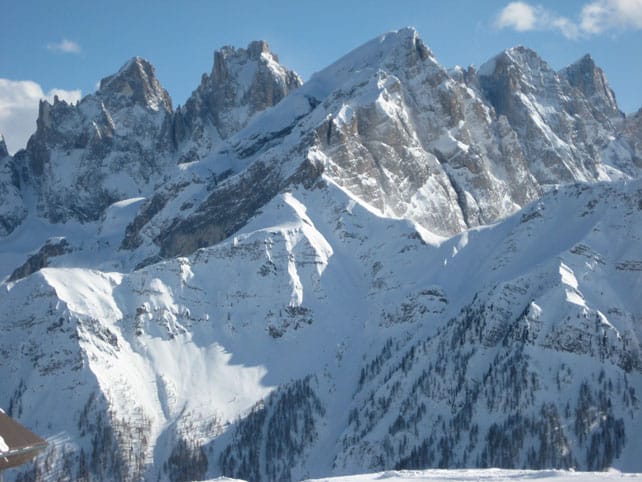
In some respects, it’s easy to see why the Val di Fassa doesn’t make the A-list. For a start, its ski areas are scattered along its length in unconnected units, and to get between them, you need to master the local bus timetable, or jump in a hire car.
The star quality of the Sella Ronda, nearby, distracts a lot of skiers too. A circuit of lifts and pistes that goes all the way round the Sella massif, it’s a unique and spectacular skiing experience, and many in the area don’t stray far from it on their holidays.
But they should: because they’ll discover a secret kingdom of skiing if they do. There are four main zones beyond the main resort of Canazei to get stuck into: Ciampac-Buffaure, Catinaccio,
Together, they offer 200km of pistes, which can all be skied on the same Dolomiti Superski pass – and the quality is exceptional. Think wide, beautifully groomed cruisers and the occasional tasty, straight-down-the-mountain blacks. Midweek, when the locals are at work, it’s not unusual to ski an entire piste on your own.
The scenery, by the way, will blow your ski boots off. Check out the view of the Pale di San Martino from top of the cable car on the San Pellegrino pass, above…
Best Run: the long drop down from the Col Margherita to the side of the road on Passo San Pellegrino. You can take your pick from a black or a red piste.
Best Restaurant: the Baita Checco at Catinaccio is the place – a deceptively laid-back place, serving serious food.
Zell am See, Austria
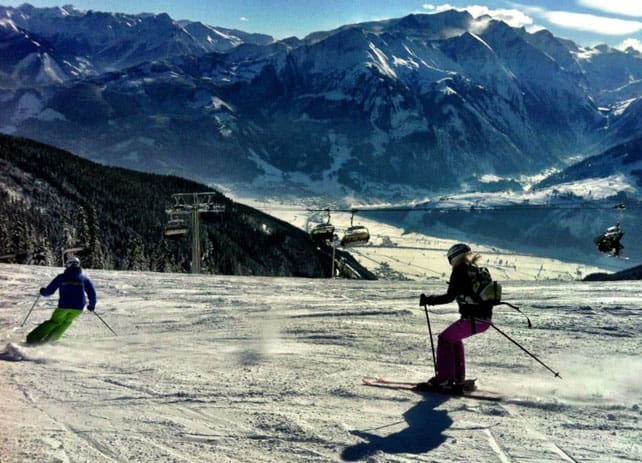
Zell am See almost always surprises skiers because they expect such a pretty lakeside town to be home to easy pistes. There are some excellent blues here: but what really sticks in the mind are the two superb blacks that plunge down the north side of the Schmitten – which is the mountain immediately above town.
In particular, the Trassabfahrt (number 14 on the piste map) is a beauty. It drops through 900 vertical metres and keeps you on your toes from top to bottom, alternating between steep, straight-down-the-mountain sections, and swooping, slam-on-the-brakes turns. It’s one of the steepest pistes in the Salzburgerland – but never so vertiginous as to be a struggle, rather than a challenge and a pleasure.
Even the easier, intermediate pistes are a challenge, because they’re so long. You can knit them together into one continuous descent that goes from the top of the Schmitten, almost all the way down to the lake at Schuttdorf. For almost the whole run, you’re following a long, evenly-pitched ridge, which seems to go on forever. It’s a great test of stamina.
Add in the snowsure skiing on the Kitzsteinhorn, which mixes easy pistes with some short, sharp off-piste routes, and you’ve got a very diverse and interesting mountain. Though, to get the best of it you need to be skiing mid-winter, in January or February, as the Schmitten section of the slopes tops out at 2000m.
Best Run: aside from the Trassabfahrt (see above), it has to be the top-to-bottom intermediate-rated run from Schmitten all the way down to Schuttdorf.
Best Restaurant: if you’re skiing down to Schuttdorf, make sure you stop at the Areitalm en route. It serves Austrian staples cooked with a light and imaginative touch, and the views towards the Kitzsteinhorn are stunning.
The Zillertal, Austria
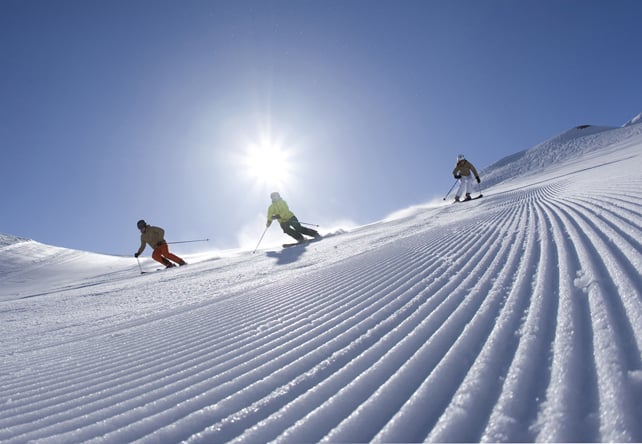
No-one would ever claim that busy, buzzing Mayrhofen is one of the unknowns of Alpine skiing. But you could certainly make the case for the rest of the valley in which it’s set. Called the Zillertal, it’s home to two other ski areas, as well as a glacier, which hardly anyone in the UK has heard of.
Combined with Mayrhofen’s own slopes, they create a winter playground of almost unparalleled variety, and considerable extent. A total of 487km of pistes are on offer here – a figure calculated using the exacting Christoph Schrahe system. According to Schrahe, that’s almost the same size as the famous Three Valleys in France.
The one drawback is the fact that the lift systems aren’t interconnected. To get between them, you’ll have to hire a car, use the well-organised public transport network of trains and buses (free to anyone wearing ski clothing and carrying skis) or join a tour operator excursion from Mayrhofen. But it’s worth making the effort.
Hintertux, at the far end of the valley, is home to the best glacier skiing in the Alps, and it’s cold and snowsure in even the sharpest spring thaw. Meanwhile, the Hochzillertal lift system includes an off-piste playground of rare quality, at Hochfugen, which has its own snowy micro-climate.
All three of the main ski areas also offer oodles of intermediate-friendly pistes both above and below the treeline, spread over a vast stretch of mountains. Best of all you can ski it all on the same lift pass!
Best Run: the Devil’s run in Mayrhofen is a classic black, steady and steep. Read more in my feature on the best skiing in Austria.
Best Restaurant: one of the most surprising things about little Hochfugen is that it’s home to one of Austria’s best chefs, Alexander Fankhauser, who cooks at his parents’ hotel, the Sporthotel Lamark.
Which Is Your Favourite?
There are of course, many other areas which warrant inclusion: so why not add your own favourites to the comments box at the end of the feature?










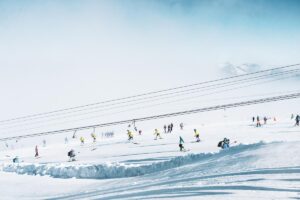
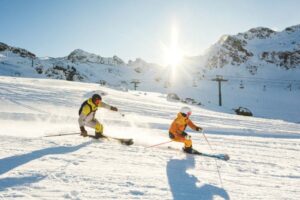
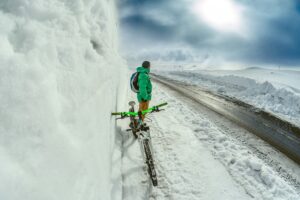
Skied Breck last week and couldn’t agree more – great spot, very underrated
La Rosiere is a true hidden gem, especially if you take the time to ski in the San Bernado Pass area which is mostly only ever used for transit. Some great opportunities there to ski untouched powder between the runs!
I agree with you, Scott, it’s an excellent place for off-piste.
We skied in Damuls in the Voralberg at 1/2 term, it’s completely undiscovered by the British market but has some excellent Red and Black pistes and one of the best lift systems we have come across several fast 6 man and 1 8 man chair which shift the queues in no time.
It looks like an interesting area, Margaret! It’s always good to hear about new places.
I ski places like Les Contamines, Megeve and Grand Bornand virtually untouched by the uk market. Just because Thomson and Inghams don’t sell packages to the masses for these destinations doesn’t mean they’re not highly rated by real skiers.. Not tourists
Personally I love Le Grand Bornand – there’s some great skiing there and it’s an attractive village too. I once had a fantastic day off-piste in Les Contamines, and Megeve is lovely too – although it’s relatively low altitude.
St Johann in Tirol & the steinplatte in Waldring are worth mentioning,amazing area
Pleased to see Serre Che getting a mention here…fantastic resort and not trying to rip people off. Miss having an apartment there but loads of happy memories :o)
Dolomiti ski pass ❤️ looooove the whole area! The quality is excellent and villages are so nice!
Don’t forget to give a look to Crested Butte Mountain Resort in CO, USA. Great skiing in a small town setting with the best food I’ve ever eaten.
Breck is the most popular resort in the US skier visit wise. If you are talking Colorado I’d suggest Steamboat and if you are talking overall US Big Sky MT